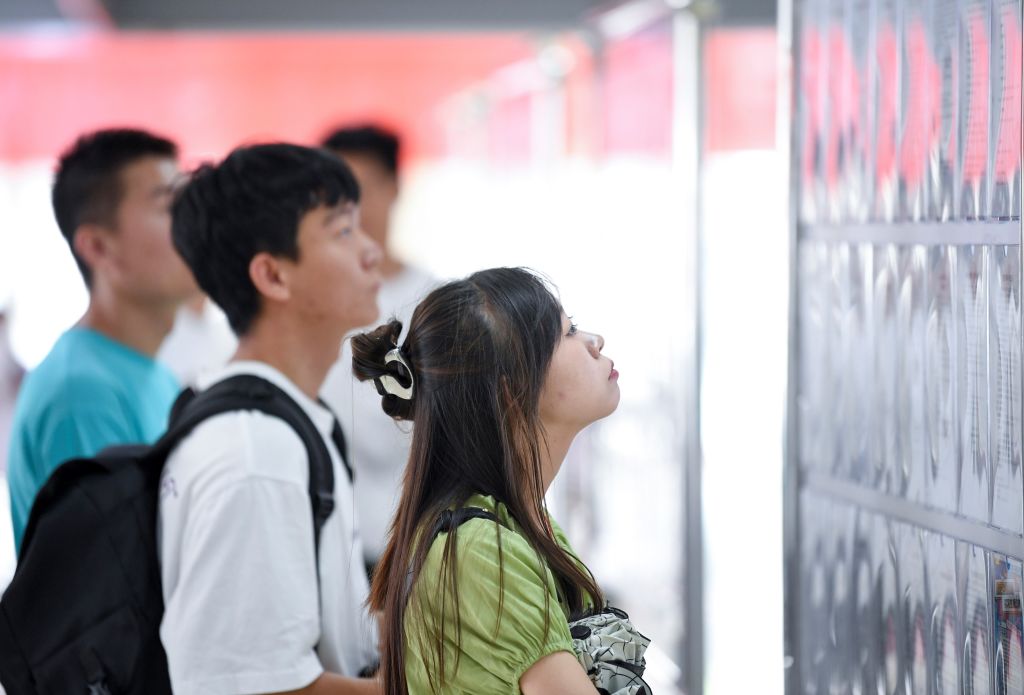
China’s youth unemployment rate hit a record high in April, with 20.4% of 16–24-year-olds unable to find jobs. Then it hit a new high in May, rising to 20.8%. It kept going up in June, to an unprecedented 21.3%.
It’s a concerning trend for the world’s second-largest economy, which already faces troubling demographic headwinds of a rapidly aging population.
The July youth unemployment rate, however, won’t set a new record. But it’s not because a solution has been found. Rather, China’s National Bureau of Statistics, which would typically share the last month’s employment data around this time, announced on Tuesday that it would suspend disclosing the country’s youth joblessness rate, citing a need to reassess its methodology.
“The main reason is because the economy and society are continually developing. Statistics work needs to keep improving,” said bureau spokesperson Fu Linghui, who specified that the bureau is reconsidering the inclusion of students in youth unemployment calculations, though only people actively seeking work are currently considered unemployed.
The latest move seems to suggest that previous numbers released have been inflated. In reality, observers have argued that the bureau has already been underestimating the country’s actual youth joblessness rate. Most other countries and international organizations, including the World Bank and the Organisation for Economic Co-operation and Development (OECD), use a 15–24 age range for calculating youth unemployment, while Beijing only counts those aged 16–24. Meanwhile, universities in China have reportedly pressured recent graduates to lie about their employment status in order to burnish the school’s reputation, which the Ministry of Education has vowed to crack down on.
(China’s stat keepers have also come under criticism in recent months for revealing that anyone working at least one hour per week is considered employed, though this is the widely-used International Labour Organization standard.)
The monthly publishing of a youth unemployment rate, which began in 2018, initially appeared to be an effort on China’s part to align itself with international standards, says Alfred Wu, an associate professor who researches Chinese governance at Singapore’s Lee Kuan Yew School of Public Policy. “But the data now looks bad,” Wu tells TIME, “and they don’t want people to look.”
“China massages data all the time,” he adds. “It’s very much a simple propaganda exercise.”
China has long been criticized for its lack of transparency. Throughout the COVID-19 pandemic, the government was accused of underrepresenting its true infection numbers and death toll. And earlier this year, Chinese authorities came under fire for suddenly restricting international access to the country’s public data, in an apparent attempt to block researchers from analyzing its science and technology policies.
Read More: China’s Solution to Inequality? Cracking Down on Displays of Wealth and Poverty
“Halting the release of youth unemployment data can reduce the public's attention to this issue,” Shan Wei, a senior research fellow of Chinese politics at the National University of Singapore, tells TIME. But, he notes, “even though the data is not being published, the issue still exists.”
“Over the long term, this situation could undoubtedly threaten the legitimacy of the Chinese government,” says Shan, adding that the Chinese Communist Party, which is keenly aware of the potential fallout, is “now focusing on both intensifying social control and improving youth employment.”
But it’s not just the official unemployment figures that authorities have to worry about. There’s also an increasing number of youths—exhausted by burnout or disillusioned by dismal prospects for social mobility—who have given up on job searching entirely and are not included in labor force statistics, or who have jobs but have decided to resist the pressure to work tirelessly.
Many in China today are choosing to “lie flat” and “let it rot,” or to return home as “full-time children”—popular slogans in a growing movement of young people embracing doing just the bare minimum or nothing at all. If these kinds of groups were included in the tally, the youth unemployment rate could be as high as 46.5 percent, argued Peking University economics professor Zhang Dandan in an article published last month in the Chinese financial magazine Caixin that has since been removed.
Chinese authorities have taken to telling youths to lower their expectations and endure hardships, though this has only exacerbated resentment among people who were told all their lives that hard work would be rewarded with success.
The decision to stop releasing youth unemployment statistics doesn’t seem likely to quell any bitterness, instead already inviting tongue-in-cheek jabs from Chinese social media users.
“This is by far the only effective policy dealing with high youth unemployment,” reads one comment on a Weibo post about the National Bureau of Statistics announcement.
“‘How did you do for your exam?’ ‘Not bad, I got most of the questions correct.’ ‘What was your score?’ ‘Not telling you,” reads another popular comment.
Adds another user: “I’m guessing this comments section will be shut down soon.”
More Must-Reads from TIME
- Why Biden Dropped Out
- Ukraine’s Plan to Survive Trump
- The Rise of a New Kind of Parenting Guru
- The Chaos and Commotion of the RNC in Photos
- Why We All Have a Stake in Twisters’ Success
- 8 Eating Habits That Actually Improve Your Sleep
- Welcome to the Noah Lyles Olympics
- Get Our Paris Olympics Newsletter in Your Inbox
Contact us at letters@time.com